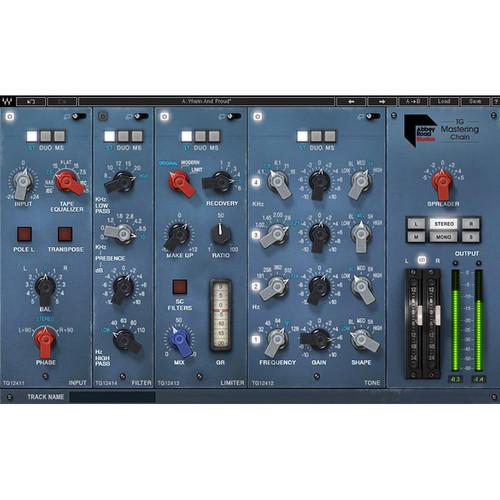User Manual for Waves Abbey Road TG Mastering Chain for Pro Audio Processing Click to enlarge the picture
 Contents of the user manual for the Waves Abbey Road TG Mastering Chain
Contents of the user manual for the Waves Abbey Road TG Mastering Chain
- Product category: Virtual Processor Plug-Ins Waves
- Brand: Waves
- Description and content of package
- Technical information and basic settings
- Frequently asked questions – FAQ
- Troubleshooting (does not switch on, does not respond, error message, what do I do if...)
- Authorized service for Waves Virtual Processor Plug-Ins
|
User manual for the Waves Abbey Road TG Mastering Chain contain basic instructions
that need to be followed during installation and operation.
Before starting your appliance, the user manual should be read through carefully.
Follow all the safety instructions and warnings, and be guided by the given recommendations.
User manual is an integral part of any Waves product,
and if it is sold or transferred, they should be handed over jointly with the product.
Following the instructions for use is an essential prerequisite for protecting
health and property during use, as well as recognition of liability on the part of the manufacturer
for possible defects should you make a warranty claim. Download an official Waves user manual in which you will find instructions on how to install, use, maintain and service your product.
And do not forget – unsuitable use of a Waves product will considerably shorten its lifespan!
|
Product description Available for download, the Waves Abbey Road TG Mastering Chain is a plug-in designed for stereo mix bus processing, particularly in mastering contexts, though it will also work on instrumental submixes, stereo instruments, and mono elements. The plug-in is modeled on a legendary mastering transfer console from Abbey Road studios, one used on classic Pink Floyd records, Radiohead albums, and more. Abbey Road allowed Waves to model this console in detail so that you can bring its sound home to your own project or professional studio.
Five modules are provided within the Abbey Road TG Mastering Chain: Input, Tone, Limiter, Filter, and Output. Other than the Input and Output sections, all the modules can all be rearranged to suit your specific workflow. The modules can be individually switched between stereo, dual-mono, and M/S configurations, depending on how you need them.
This software is compatible with Mac and Windows platforms, and operates in AU, VST, AudioSuite, and AAX formats. It works both in native applications, and with SoundGrid for live use. - Input Module
-
- The Input knob controls the input level, from -24 to 24 dB in 0.1 dB increments.
- The Tape Equalizer applies a filter that flattens out the frequency spectrum. It models the EQ in tape machines that compensate for NAB- or IEC-equalized tape at either 7.5 or 15 ips. In your digital mix, you can use this knob to impart tonal character across buses or mixes, or you can forego it.
- The Pole button flips the input phase by 180°. In stereo mode, you'll see Pole L and Pole R, for flipping either or both channels.
- The Transpose button transposes the left and right channels, and is useful for checking if the vocal—or other appropriate element—is truly in the center of the mix.
- The Balance knob changes the level relations between the left and right channel, providing you -5 to 5 dB of balance in 0.05 dB increments.
- The Phase knob shifts the phase of one channel relative to the other by 90°. This is useful for stereo tracks that have phase correlation problems between the left and right channel.
- Tone Module
-
- The Tone module is a musical, versatile four-band EQ. Each band has five fixed cutoff points, as well as five filter shapes. The fixed frequency points are as follows:
- Band 1: 32, 45, 64, 91, 128 Hz
- Band 2: 181, 256, 362, 512, 724 Hz
- Band 3: 1.02, 1.45, 2.05, 2.6, 3.25 kHz
- Band 4: 4.1, 5.8, 8.1, 11, 16 kHz
- You're provided gain controls for each band, giving you -10 to +10 dB in 0.05 dB increments. Additionally, you're provided selectors for filter type and shape on a per-band basis. Here's a breakdown of those:
- Low: A low-shelf filter
- BL: A blunt, wide bell filter
- MED: A medium-blunt, moderately wide bell filter
- SH: A sharp, narrow bell filter
- High: A high-shelf filter
- Each band can be engaged or disengaged on an individual basis. Also, you can solo each band for monitoring purposes within the expanded view pane. This monitoring option can give you a greater degree of control.
- Limiter Module
-
- The Limiter module lets you choose between the Zener diode compressor/limiter found in the original TG12413, and a specially designed VCA-based compressor designed to meet modern mastering requirements. Linear-phase filters and phase-coherent sidechain filters are accessible via the Expanded View pane. You can toggle between three modes of dynamic processing, which are as follows:
- Original: The TG12413's original Zener diode compressor
- Modern: A VCA-based compressor, designed with low-level compression in mind in order to suit modern-day mastering uses
- Limit: The limiter mode of the Zener diode; the knee is much harder compared to Original mode, but please note this is not a brickwall limiter, and transients can sneak past to the digital ceiling
- A Recovery knob selects among six different time constants. Think of them as combinations of attack/and release. The higher the recovery value, the longer the perceived attack/release time. You will need to experiment with each setting to see how it benefits your mixes.
- A Make Up control is on hand should you need to raise the overall level after you've compressed the signal. Please note the Make Up control only affects the compressed signal path. Should you use the Mix knob to introduce direct, unprocessed signal into the chain, the Make Up knob will only affect the compressed material.
- A Ratio knob sets the VCA input/output curve, and operates in values of 1 to 100, rather than with ratios of 2:1, 3:1, etc.
- In the expanded view, you can use three linear phase sidechain filters to tell the compressor to ignore certain frequency bands, and thus, to achieve different compression behaviors. The sidechain filter provides options, such as high-pass, bell, and low-pass filtering.
- Filter Module
-
- The Filter Module is a musical three-band filter with high-pass, low-pass, and presence controls. They break down as follows:
- High Pass: Choose from four possible HP frequencies (40, 63, 80, and 110 Hz); low functions as off
- Presence: Choose from eight fixed cutoff points of a medium-blunt bell; your options are 0.5, 0.8, 1.2, 1.8, 2.8, 4.2, 6.5, and 10 kHz, at a range of -10 to +10 dB in 0.1 dB increments
- Low Pass: Choose from five fixed cutoff points: 20 kHz, 15 kHz, 12 kHz, 10 kHz, and 8 kHz; High functions as Off
- TG12416 Output Module
-
- The Output Module sports a Stereo Spreader knob precision-modeled on the original EMI TG12416 unit. It applies a sum/difference matrix to the signal and manipulates the gain relations between them, making the stereo image appear wider or narrower, depending on how you tweak it. Its range is -5 to +5 dB in 0.1 dB increments.
- The Monitoring section lets you listen to the output signal in a variety of ways. You can monitor the left or right channels separately, monitor the mids and sides on their own, or listen to a mono fold-down.
- The large Output Fader controls the overall output level, ranging from -24 dB to +12 dB in 0 dB increments. You can link these faders or change their levels independently. An output meter shows a peak reading of the overall output level.
- Abbey Road Meter Bridge
-
- Three classic metering options are provided with this emulation:
- PPM meter: This monitors peak levels.
- VU meter: This helps you keep an eye on your average level.
- Phase correlation meter: This helps you see if your signal is hovering out of phase.
- You can use the level meters on the input, output, or to monitor gain reduction.
- One instance of this plug-in will monitor all instances of the Abbey Road TG Mastering chain in your session. Simply select the name of any affected track in the Track Name window to jump select among instances.
Table of Contents
|
Upload User Manual
Have you got an user manual for the Waves Abbey Road TG Mastering Chain for Pro Audio Processing in electronic form? Please send it to us and help us expand our library of instruction manuals.
Thank you, too, on behalf of other users.
To upload the product manual, we first need to check and make sure you are not a robot. After that, your "Submit Link" or "Upload File" will appear.
Technical parametersWaves Abbey Road TG Specs | Mac Requirements | macOS 10.11.6 or laterCPU
Intel Core i5 / i7 / Xeon
Memory
8 GB RAM
8 GB free hard-disk space
Screen Resolution
Minimum: 1024 x 768
Recommended: 1280 x 1024 / 1600 x 1024
USB displays are not supported as the primary display.
Support for Visually Impaired Users
macOS Sierra 10.12.4
VoiceOver utility enabled
Pro Tools 12.7
Logic 10.3.1 | | System Requirements (Windows) | Windows 7 with SP1, Windows 8.1, Windows 10 (all 64-bit)CPU
Intel Core i3 / i5 / i7 / Xeon / AMD Quad-Core
Memory
8 GB RAM
8 GB free hard-disk space
Screen Resolution
Minimum: 1024 x 768
Recommended: 1280 x 1024 / 1600 x 1024 | | Supported Plug-In Formats | AU, VST, VST3, AAX, and AudioSuite | | Sample Rate | Supports up to 192 kHz | | Operation | Mono, stereo | | Latency | 44.1 and 48 kHz: 8395 samples (full component)
88.2 to 96 kHz and 176.4 to 192 kHz: 16,512 samples (full component) |
Rating100% users recommend this product to others. And what about you?

This product has already been rated by 35 owners. Add your rating and experience with the product.
Discussion
 Ask our technicians if you have a problem with your settings,
or if anything is unclear in the user manual you have downloaded.
You can make use of our moderated discussion.
The discussion is public and helps other users of our website who may be encountering similar problems.
Ask our technicians if you have a problem with your settings,
or if anything is unclear in the user manual you have downloaded.
You can make use of our moderated discussion.
The discussion is public and helps other users of our website who may be encountering similar problems.
The discussion is empty - enter the first post
Post a new topic / query / comment:
|
|

